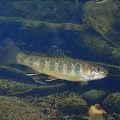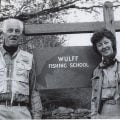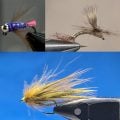How to Tie a Last Chance Purple Haze
Producer: Tim Flagler
This rather unkempt-looking fly is a mash-up of two of my favorite patterns, the Last Chance Cripple and Andy Carlson’s Purple Haze. I’ve yet to find a hatch where it doesn’t work.
For a hook, I’m going to use a Fulling Mill Ultimate Dry in size 14. After getting the hook firmly secured in the jaws of my tying vise, I load a bobbin with a spool of UTC 70 Denier in purple. Get the thread started on the hook shank, leaving an eye-length space behind the eye, and take a few wraps rearward before snipping off the excess tag.
Moose body hair is used for the tail of the fly. Snip a dozen or so hairs free from the hide then strip out all the fuzzy underfur. Place the hair, tips first, into a stacker and give it a little stack. I like to trim off the somewhat unwieldy butts. Give the hair a thorough stacking then tilt your stacker and tap a few times to concentrate the hair in the bottom of the tube. Remove the hair from the stacker by the aligned tips then pass it to your right hand, while keeping those tips aligned. Measure to form a tail about a hook shank in length then transfer that measurement rearward to the start of the bend. Start taking thread wraps to secure the hair to the top of the hook shank. Make sure it’s bound down really well all the way to the start of the bend. Lift the butt ends up and snip them off at a shallow angle. Advance your tying thread forward up the hook shank, covering the butt ends along the way.
Golden brown Antron yarn is used to represent a partial trailing shuck. Snip a 2” segment free from the spool then separate it in half lengthwise. Save one half in a safe place for use on the next fly. Place the snipped off ends of the other half on top of the hook shank and take 3 or 4 somewhat loose thread wraps rearward to corral the yarn. Gently pull on the material to shorten the butt ends then continue taking thread wraps rearward to the base of the tail. Advance your thread forward so it hangs at the hook point. Snip the Antron off so it extends just about halfway down the tail of the fly.
Purple rabbit fur dubbing is used to create the body of the fly. Pull a small clump free from the packet and use it to produce a slender dubbing noodle on your tying thread, that’s about 2” in length and tapered at both ends. Start taking wraps with the noodle so the dubbing begins right at the base of the tail. Continue taking touching wraps forward, up the hook shank, to build up a nicely tapered abdomen on the fly. Keep taking wraps over top of the butt ends and all the way up to the initial tie-in point. Then, take a few turns rearward to establish the back end of the fly’s thorax.
Two natural white CDC feathers are used to form the wing of the fly. Align their tips then pull the fibers forward into a small clump, like so. Measure to form a wing a hook shank in length and transfer that measurement forward to the location of your tying thread. Take a few nice, tight thread wraps to really anchor the wing then once again, wrap rearward to the back end of the thorax. While maintaining your grip on the butt ends of the CDC, lift up and snip them off so they extend a little more than halfway down the abdomen of the fly.
I like to use 2 different hackle feathers to hackle the fly, one brown and one ginger grizzly. To me, the combination looks just plain yummy. Be sure to measure each feather to confirm that it’s the correct size before plucking it free from the skin. Pull down and strip off all the lower webby fibers from the stems of both feathers. With the shiny side of the feathers facing you, align their lowermost fibers. Lay the stems against the near side of the hook and take thread wraps to secure them. Make sure they’re bound down really well, almost to the base of the wing. You can then lift each of these stems up and snip them off close. Take a couple more wraps to cover the butt ends.
Get hold of the tip of one of the feathers with hackle pliers and start taking wraps with it. Leave just a small amount of space between wraps. When you reach your tying thread, use it to firmly anchor the feather’s tip. Use your tying scissors to carefully snip the excess off close. Get hold of the second hackle feather by its tip and start taking wraps with it. This time wrap between the wraps of the previous hackle. Then once again, when you reach your tying thread, use it to anchor the tip and snip the excess off close.
Pull the wing up and back and take a few wraps around the shank at the back edge of the hook eye. This should prop the wing up just a little. Get hold of your whip finish tool and use it to do a 3 or 4 turn whip finish, seat the knot well and snip or cut your tying thread free.
This Last Chance Purple Haze doesn’t look super neat and it’s not supposed to. It’s intended to imitate a mayfly struggling on the water’s surface, trying to free itself from its nymphal shuck and unfurl its wings. Not really fit for Instagram, but then again, trout don’t follow Instagram.
How to Tie a Klinkhamer
How to Tie a Leisenring Spider











